Here are some of the best Types of Marigolds you can grow, and decide which one is the most gorgeous of them all.

The bright colors of marigolds can make any garden look fabulous. They also make great companion plants for vegetables and attract pollinators! So, which one should you pick for yourself? Here’s a good overview of the best Types of Marigolds!
Learn to Grow Marigold from Cuttings to Propagate More Plants Quickly
Types of Marigolds
1. French Marigolds

Botanical Name: Tagetes patula
Height/Spread: 6-12/5-12 inches
French marigolds are bushy annuals with semi-double, double, or crested flowers in orange, red, and yellow shades. They bloom from early summer till frost and produce flowers and foliage with a spicy fragrance.
Best Varieties
- Hero Series: Double carnation flowers on a tall plant in yellow, orange, and maroon shades.
- Little Hero Series: Produces combinations of orange, maroon, and yellow double carnation flowers.
- Bonanza Series: This compact and bushy plant produces wide double carnation flowers in maroon, yellow, and orange shades.
- Boy O’ Boy Series: It features orange, yellow, and maroon blooms.
- Janie Series: This variety is ideal for growing in pots. It showcases early-blooming, double-carnation flowers in yellow, orange, and maroon colors.
- Aurora Series: It forms anemone-like flowers in yellow, orange, and maroon shades.
2. African Marigolds

Botanical Name: Tagetes erecta
Height/Spread: 12-40/12-24 inches
Also popular as the Aztec or American marigold, it has large, double flowers in yellow, orange, and white. Both flowers and foliage emit a strong scent, which can help ward off rabbits and other animals.
Best Varieties
- Jubilee Series: It produces double flowers in shades of orange and yellow.
- Gold Coin Series: This variety offers large, double blossoms in yellow, orange, and gold colors.
- Safari Series: It features large flat blooms in yellow, orange, and maroon shades.
- French Vanilla: It displays elegant, creamy white flowers.
3. Triploid Hybrids Marigolds
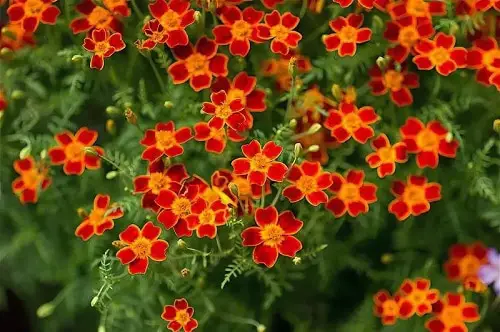
Botanical Name: Tagetes erecta x Tagetes patula
Height/Spread: 12-24 inches
A cross between African and French marigolds, they grow super large flowers that bear hot seasons quite well. They can be a little challenging to grow.
Best Varieties
- Zenith: It offers showy flowers in orange, red, and yellow; it comes in two types of Carnation.
- Nugget: This variety is not as popular, but the double flowerheads come in gorgeous shades of orange, yellow, red, and gold.
4. Signet (Single) Marigolds
Botanical Name: Tagetes tenuifolia
Height/Spread: 12-18 inches
This edible variety makes them different from the rest. You can enjoy them in salads for added sweetness. The plant displays abundantly rich-colored, small, showy, single-flowers with lacy foliage.
Best Varieties
- Lemon Gem: It comes in a canary yellow shade and blooms all summer.
- Red Gem: This is a small variety that offers blooms in red shade.
- Irish Lace: It is a short plant featuring tiny white blooms and lacy leaves.
5. Wild Marigold
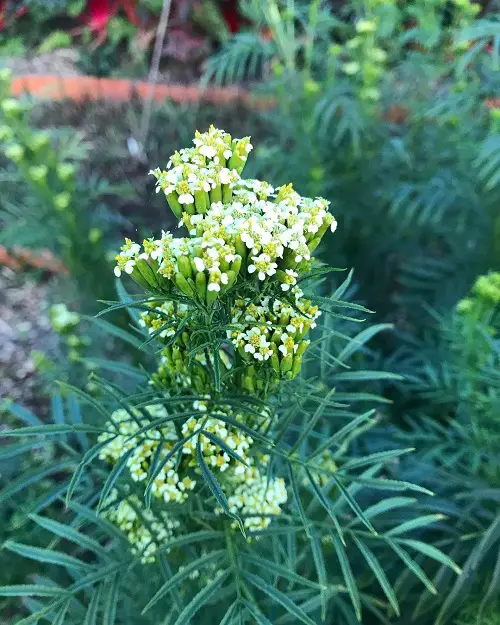
Botanical Name: Tagetes minuta
Height/Spread: 6-24/6-10 inches
Wild Marigold has small flowers packed in terminal clusters within a green sheath. Its leaves are edible and are also used in making herbal tea. The oil derived from the plant is used for making perfumes.
6. Mountain Marigold
Botanical Name: Tagetes lemmonii
Height/Spread: up to 6/up to 10 feet
The plant is a drought-tolerant variety that produces bright yellow flowers in late winter to early spring. This shrub-like plant grows up to 6 feet tall and wide and has fern-like foliage.
The plant’s strong fragrance is used to repel pests and is commonly used in companion planting.
7. Spanish Tarragon

Botanical Name: Tagetes lucida
Height/Spread: 14-15/8-12 inches
Also famous as the ‘abnormal’ Marigold, this medicinal plant has beautiful yellow flowers that are edible and carry an anise note. It is also a part of the Herbes de Provence.
Plants that are also Popular as ‘Marigold’ but are not part of the ‘Tagetes’ Genus
8. Pot Marigold
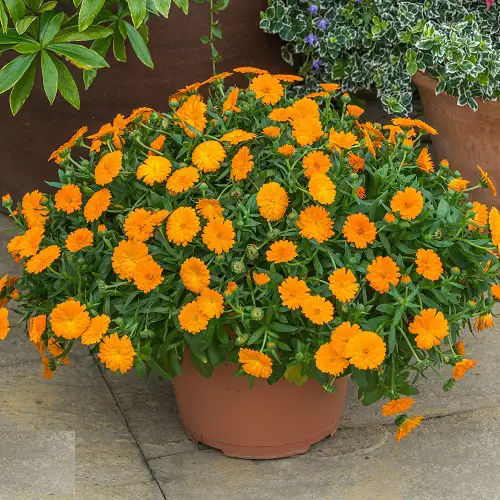
Botanical Name: Calendula officinalis
Height/Spread: 12-14/8-12 inches
Not a true marigold–it is a part of the Aster family. Thanks to its edible flowers, people grow it for both ornamental and culinary purposes. It comes in striking shades of orange, pink, cream, and yellow.
Best Varieties
- Touch of Red: Has orange and red flowers with petals having a red tip.
- Greenheart Orange: This variety has orange flowers with a green center.
- Bronzed Beauty: Comes in cream and peach flowers.
- Radio Extra: This one is a tall plant with cactus-like orange flowers.
- Sherbet Fizz: Grows buff-hued flowers with red undersides.
9. Marsh Marigold
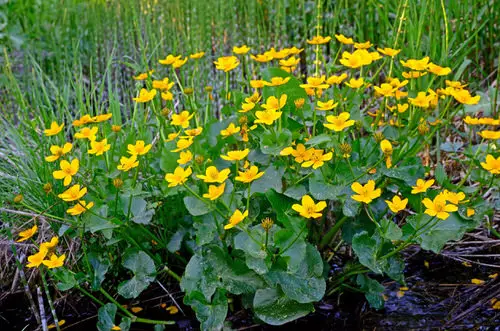
Botanical Name: Caltha palustris
Height/Spread: 8-24/12-24 inches
Marsh Marigold is a water-loving plant that produces bright yellow flowers in early spring. It grows in moist areas such as swamps, ditches, and along streams. The plant’s shiny dark green leaves and vibrant flowers make it an attractive addition to any water garden.
10. Desert Marigold
Botanical Name: Baileya multiradiata
Height/Spread: 8-20/4-12
Desert Marigold is a resilient plant that thrives in arid conditions. This plant produces yellow daisy-like flowers with a darker center and blooms from early spring to late fall.
Its gray-green leaves and long flowering period make it a great choice for xeriscaping.
11. Cape Marigold

Botanical Name: Dimorphotheca sinuata
Height/Spread: 4-18/12-24 inches
The Cape Marigold is a colorful plant that produces a profusion of daisy-like flowers in shades of pink, orange, and yellow. This plant grows up to 18 inches tall and prefers full sun and well-drained soil.
This flower’s unique characteristic is that its flowers close up at night and on cloudy days, making it a great addition to a garden or landscape.
Propagating & Growing Marigolds
- You can grow them from both seeds and softwood cuttings.
- Zones 8 or higher can be grown all year long.
- Plant them after the first frost in your area.
- Marigolds do best in bright sunlight. Pick the spot accordingly.
Container Size
It depends upon the variety you are growing. For French, Signet, and Pot Marigolds, 6-8 inches pots will suffice. For bigger varieties like African Marigolds, take a pot of 10-12 inches. If the pot is small, go with the ‘one plant per one pot’ rule.
Requirements for Growing Marigolds in Pots

Location
This plant is in love with sunlight. The more, the merrier it will be for the flowers and their magnificent colors.
Soil
Marigolds are not fussy about soil requirements. Your regular potting soil will work just fine. If you want the best results, use loamy soil with some water retention capability.
Watering
Water them well and let the soil dry a bit before you reach for the can again. The drainage holes in pots will do their work to drain the excess water out. Avoid watering the foliage.
Marigold Care in Pots

Fertilizer
A 5-10-5 or 10-10-10 blend will work just fine. The key here is to use a less amount than recommended on the label, as over-fertilizing the plant will hurt the flowers. Applying a liquid fertilizer once in two to three weeks diluted to 1/4 or 1/2 of its recommended strength should be fine.
Deadheading and Pinching
Just snip off the spent flowers as you see them. This will encourage new blooms. Pinching the tips of your marigold, especially when it is young, is also important to get a fuller plant.
Pest and Diseases
Spider mites and aphids love marigolds. Gentle use of insecticidal soap or neem oil will keep them at bay.
Fungal diseases like powdery mildew can attack these plants often if they’re kept too wet. To avoid this, keep the leaves dry and provide proper air circulation and full sunlight.



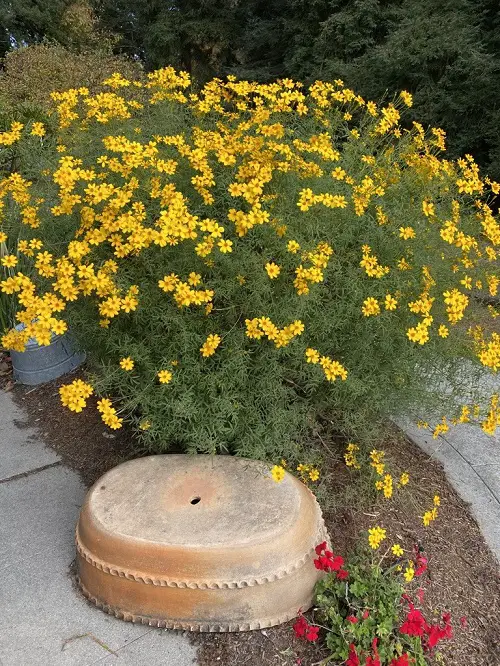
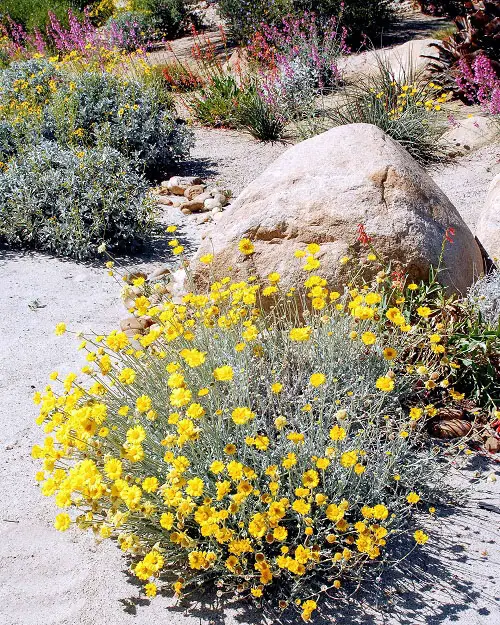

My indoor crackerjack marigolds have little bumps on them. I found out that they were just root ready to grow. So I buried it about 8 inches more into the pot and the bumps are still appearing and half way up the plant! I don’t know what to at this point!
One of the plants, I can put seed s in the ground in spring ,and have beautiful fall color! I enjoy deadheading them for the spices smell ,I have on my fingers afterwards.